Striding across the USS Missouri battleship, with a group of sailors in her thrall, Cher cut a very charismatic figure—and a very revealing one. For the music video for her 1989 song “If I Could Turn Back Time,” the actress/singer wore a sheer black bodystocking that left very little to the imagination.
At the close of the ‘80s, a time when sex appeal seemed to dominate both movies and music, Cher likely didn't express too much concern over her choice of apparel. But when the video began airing on MTV, Cher’s visible backside drew a major backlash—both from viewers and the U.S. Navy—and a cable channel suddenly got very conservative in their programming choices.
Cher Madness

Cher had, of course, built a career not based on provocation but talent. Born Cherilyn Sarkisian on May 20, 1946, the aspiring performer moved to Hollywood at the age of 16 and married Sonny Bono. As co-host of The Sonny and Cher Comedy Hour (1971-1974) and later in films like Silkwood (1983), Mask (1985) and Moonstruck (1987), her formidable abilities onscreen and behind a microphone had made her a singular phenomenon.
After focusing on her movie career for most of the 1980s, Cher returned to music in 1987 with an album, Cher. That was followed by 1989’s Heart of Stone, which was populated with several hits like “Just Like Jesse James” and the title track. But it was “If I Could Turn Back Time,” which was written by Diane Warren, that proved to be the most memorable track.
For the video, Cher planned to serenade roughly 200 actual sailors on the Naval battleship Missouri, which was docked in Long Beach, California. Nicknamed Mighty Mo, the ship had a storied history, having been in operation during World War II when Japan’s forces surrendered onboard with General Douglas McArthur in attendance.
Mission: Outrageous
The Navy, as it does with most productions that request their assistance, wanted assurances that they wouldn’t be portrayed in a negative light. But, as the Los Angeles Times reported, no one at the branch’s liaison department bothered to ask what kind of costume Cher might be wearing.
According to the video’s director, Marty Callner, who was quoted in 2012’s I Want My MTV: The Uncensored Story of the Music Video Revolution, Cher asked Callner what she should wear for the shoot. “Something outrageous,” Callner told her.
It certainly didn’t fit the Naval dress code. When Cher boarded the ship over the July 4 weekend in 1989 for filming, she was sporting a sheer bodysuit with a black leather jacket, garter belt, and boots. The apparel was so transparent that one could observe two tattoos on Cher’s buttocks. Only a single piece of black cloth prevented Cher from a full reveal.
A Naval representative named Steve Honda was watching filming. When he saw Cher, he gulped and insisted Callner tell her to put something else on. “You go tell her she can’t wear it,” Callner remembered telling him. Honda declined.
Bodystockings & Borderlines

Once the video began airing, it was met with some scathing critiques by both military personnel and the general public. One retired (and unnamed) commander wrote to the Navy saying he would be “deeply embarrassed” if he had been assigned to the ship. Another viewer wrote to both the Navy and to then-President George H. W. Bush to alert them to Cher’s “rear end nude” appearance and her dismay at the Navy “putting its stamp of approval on trash like this.”
In response, Navy Lieutenant Commander A.J. Dooley said the production had not disclosed its plans for Cher’s cheeky appearance and blamed it on a last-minute costume change. In response, a spokesperson for Geffen Records, which released the album and song, said Navy personnel had seen storyboards, including one of Cher in a see-through ensemble. No objections were raised.
Despite its reputation for a rock ‘n roll approach to programming, MTV was also taken aback. “When we accepted it, we felt it was borderline,” the network's then-vice president for programming Abbey Konowitch told press in August 1989. “We received a great deal of negative feedback from the audience.”
They certainly did. In Texarkana, Texas, the city council lobbied to have MTV removed from their cable channel lineup. They didn’t succeed, although the local cable operator did agree to offer a “trap” to customers wishing to block MTV from their home's cable feed.
The Beat Goes On (After Hours)

It’s hard to say that the controversy was a bad thing for either Cher or MTV, as the resulting publicity almost certainly boosted awareness of the song. But after eight weeks of being in “regular rotation,” or constant daytime and primetime play, MTV still took the unusual step of relegating “If I Could Turn Back Time” to airing only after 9 p.m. or 10 p.m., when it was presumed mostly older viewers would be watching.
Cher’s video was perceived to be part of an overall crackdown of lewd imagery at the channel, which also placed black bars over some body parts in Aerosmith’s “Love in an Elevator” video that same year. That video was also directed by Marty Callner.
The outfit’s significance as a cultural lightning rod didn’t escape the attention of Julien’s Auctions, which placed a version of it worn by Cher in concert in 2002 up for bid in June 2021; it sold for $115,200. (She wore it another time during the 2010 MTV Video Music Awards.) It’s not known whether the Navy’s hoped-for conclusion—that the video might boost their recruitment efforts—ever came to fruition.
Not all Naval officers were offended. One told The New York Times that the video made the Navy seem like a "neat place to be."
